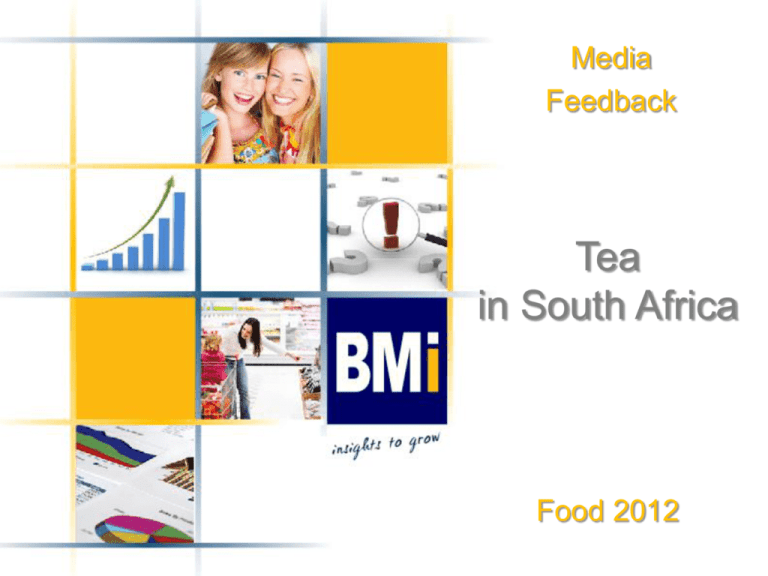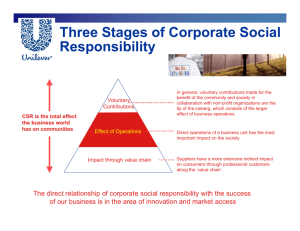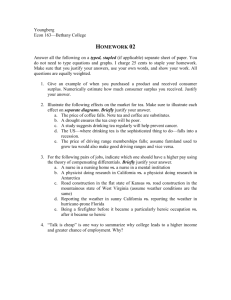
Media
Feedback
Tea
in South Africa
Food 2012
Product Definitions
Product
Definition
Black Tea
Black tea is prepared from the evergreen “Camellia sinensis” bush. Previously known as
“Ceylon Tea”. However, given the reduced content of tea originating from Sri Lanka
(previously Ceylon), it was necessary to adjust the product terminology.
Black tea undergoes a process of oxidation or fermentation, where the excess moisture is
removed from the tea leaves, before they are crushed, fermented and then dried. The
result is leaves that are brownish or black in colour.
Presently, no regulatory standards exist regarding iced tea, making it difficult to
differentiate between chilled tea beverages containing real tea solids/concentrates and
chilled beverages with tea flavourings.
Locally, iced tea is available in two types:
Iced Tea
Ready to drink
Powder concentrates
This report covers both types, where iced tea is combined with dry tea categories; the
volumes have been dehydrated at the ratio of 87g of dry concentrate to 1 litre of iced tea.
2
Product Definitions (Cont.)
Product
Rooibos
Definition
Rooibos is an herb native to the Cedarburg region in the Cape. The needle-like leaves of
this plant are used to make an aromatic hot or cold beverage. Once harvested, the
leaves are bruised, fermented and dried before being weighed and packaged.
Rooibos is a specific product for South Africa, but due to the popularity of the product,
there has been an increase in exports.
Speciality Tea
This category incorporates beverages that have an herbal base, rather than a tea base.
As these are strictly not a tea, they are often termed herbal infusions rather than herbal
tea. Infusions are defined as being brewed from the leaves, flowers, roots, bark and
seeds of herbs and spices. Although Rooibos strictly falls under this definition, the
product category is sufficiently large to stand as a category on its own.
3
Market Trends
4
Market Trends
Black Tea
•
Black tea continues to have the greatest share of the tea market (56.0%). However, the category
volume share has fallen by 2.3% as rooibos and speciality teas have gained ground.
•
Globally, tea is the second most consumed drink after water. This mature category saw a slight
decline in 2011 and marginal growth is expected in 2012.
•
The 100-280g pack range continues to be the most popular pack size range comprising more than
half of total black tea volumes for the base year.
Iced Tea
•
For another year slower single digit growth was seen within the ice tea market. This is the lowest
volume growth in the history of the category. The rate of volume started to decline in the midst of
the global recession as the economic slowdown put a cap on consumer spending.
•
The recent stabilisation of the category in terms of volume growth could indicate organic market
growth saturation. This would imply that new product offerings and innovative brand positioning
coupled with linked marketing strategies are areas left to explore to ensure continuous market
share stability against other non-alcoholic ready to drink beverages.
•
The outlook for the category remains positive but conservative.
5
Market Trends (Cont.)
Rooibos
•
The popularity of rooibos continues to grow with the category showing an increase in volumes in
2011. This is the second consecutive year in which double digit growth has been experienced.
•
The rooibos market share continues to rise as South Africans migrate from traditional black teas to
rooibos. It is believed that this is largely due to the prevalence of the trend towards health and
wellbeing.
•
Unlike the other tea categories, a large percentage of rooibos volumes are exported, however,
export volumes have remained fairly static in recent years.
•
The outlook for rooibos remains positive with growth expected for 2012 and 2013.
Speciality Tea
•
Speciality tea continues to increase in popularity. Herbal and fruit teas with functional benefits,
such as aiding digestion, are growing in popularity among health conscious consumers.
•
However, as this niche category only makes a minor contribution to total tea volumes it did not
have a significant impact on the total volume growth of the tea category.
6
Total Volume
Breakdown – Tea 2011
2.6%
33.9%
Black Tea
Iced Tea
Rooibos
56.0%
Speciality Tea
7.5%
Channel Distribution
– Tea 2011
18.2%
26.5%
4.7%
3.5%
Export
Foodservices Direct
Industrial
Retail
Wholesale
47.0%
Local Regional Distribution
Tea - 2011
14.3%
10.9%
1.8%
7.0%
Eastern Cape
4.8%
Free State
Gauteng
4.8%
KwaZulu-Natal
5.2%
Limpopo Province
Mpumalanga
28.2%
North West Province
Northern Cape
Western Cape
23.2%
Note: Excludes Exports
Percentages may not add to 100.0% due to rounding
Packaging Demand Pack Size
Black Tea - 2011
3.0%
12.4%
27.0%
70g or less
100g - 280g
400g - 500g
1.5kg or
more
57.7%
Packaging Demand Pack Type
Black Tea - 2011
2.2%
0.2%
0.1%
29.7%
37.5%
Bag in Box
Carton
Flexible Plastic
Foil/Metalised Film
Rigid Plastic
Woven PP Sacks
30.3%
Packaging Demand Pack Size
Iced Tea - 2011
1.8%
3.1%
18.0%
32.2%
250ml
0.8%
300ml
330ml/340ml
350ml
450ml/520ml
1 Litre
1.9%
1.5 Litres
42.2%
Note: Iced tea rehydrated
Packaging Demand Pack Type
Iced Tea - 2011
18.5%
2.4%
Can
2.4%
Carton
Glass
Rigid Plastic
76.7%
Note: Iced tea rehydrated
Packaging Demand Pack Size
Rooibos - 2011
32.0%
45.0%
125g or less
150g - 600g
9kg or more
23.0%
Packaging Demand Pack Type
Rooibos - 2011
4.5%
29.8%
44.0%
Bag in Box
Carton
Flexible Plastic
Foil/Metalises Film
Paper
8.1%
13.6%
Packaging Demand Pack Size
Speciality Tea - 2011
48.8%
51.2%
100g or less
125g or more
Packaging Demand Pack Type
Speciality Tea - 2011
8.0%
25.2%
Bulk/As Required
Carton
Other
66.9%
BMI Research
Information
18
Annual Quantifications
Total Market Quantification for 140 CPG Categories
What are the latest market trends? And:
•
Is the category growing or declining?
•
What does the future hold for the category?
•
What are packaging trends for the market?
•
Are category sales growing or declining in retail, wholesale or export?
•
How is your product performing in foodservices?
Market Quantification involves sizing up markets annually to see volume, value and consumption trends.
The service is available for most food, beverage, confectionery and snack products. We have more than
10 years of historical data in tracking each market. Using these insights, you’re able to harness the
potential in your market by understanding strategic category trends across the total market.
A unique offering incorporating formal and informal market components.
Total market includes retail, wholesale, foodservices, industrial and exports.
19
BMI Tracking Report Schedule
2012
REPORT NAME
PUBLICATION
REPORT NAME
Bottled Water
All Reports
Carbonated Soft Drinks
Packaging Overview
Packaging
Paper & Board
QPM
Cordials and Squashes
Non-Alcoholic
Beverages
Mague
Full Report (all reports below)
Sport Drinks and Energy Drinks
Dairy Juice Blends
Flavoured Alcoholic
Beverages
Drinking Yoghurt
Dairy Beverages
Malt Beer
Alcoholic Beverages
Sorghum Beer
Fruit Juice
Iced Tea
Quarterly Import
Annual Beverage
Reports
PUBLICATION
Flavoured Milk
Maas
Milk
For further enquiries please contact research@bmi.co.za
Spirits
Wine
20
BMI Tracking Report Schedule
2012 (Cont.)
REPORT NAME
PUBLICATION
PUBLICATION
Biscuits and Rusks
Baked Products
Breakfast Foods, Pasta and Rice
Baking Aids
Dairy
Eggs
Desserts
Annual Food
Publications
REPORT NAME
On Request
Frozen and Par-Baked Products
F & C Beverages
Maize and Wheat
Fats and Oils
Premixes
Pre-prepared Meals
Processed Meat Products
Protein
Ice Cream
Sauces
Soups and Condiments
Sweet and Savoury Spreads
Value Added Meals
Confectionery and Snacks
Packaging of Snack Foods
South African Confectionery Market
The Impulse Market in South Africa
For further enquiries please contact research@bmi.co.za
21
ISOS
(In Store Observation Services)
How is your brand performing in-store?
Every week, we answer questions like:
•
Is my product available on shelf?
•
Does my brand have its fair share of shelf space?
•
Is my product listed and available in all stores?
•
Is my gondola end in store?
•
Do I have promotional activity in that particular store?
ISOS: Gives first-hand insight into your brand’s performance in-store. Monitor your products versus your
competitors’ to assess your performance and remedy gaps. Ensure accurate data which translates into
tactical competitive advantages.
22
Print Ads Promotional
Pricing and Share of Spend
Is your product visible enough in promotional print Media?
Assess whether your brand is gaining sufficient share, relative to your spend on promotional print
advertising. Track competitor promotional pricing to tactically react on your own product pricing.
Daily, we answer questions like:
•
What is the promotional pricing?
•
What is the regional promotional pricing variance?
•
What are competitors’ pricing tactics?
•
What Rand value is spent on our brand versus competitor brands by retailers?
•
Are we losing market share because of this?
Coverage:
•
National daily and weekly newspapers
•
Weekly community newspapers
•
Consumer magazines
•
In-store broadsheets
Print Ads: Covers all brands advertised in all regions by retailer by month. The analysis provides an inside
picture of the retail promotional environment. Track competitor promotions and pricing, offering top line or
granular data.
23
Commissioned Research
Need to investigate the market regarding other issues?
If your research need is not covered by our standard set of services, we will tailor-make a study specifically
for you.
BMI’s Commissioned Research is designed specifically to answer your questions in your particular
market. From industrial assessments to traditional consumer studies, we have the expertise to grow your
business.
These may include:
•
Consumer Research
•
Qualitative Research including Focus Groups and In-depth discussions
•
Quantitative Research solutions across various target markets
•
Service Quality Measurement (SQM)
•
Pack Type Testing and Preference
•
Product Testing includes taste tests and new product development
24
LISP
(Liquor In Store Pricing)
How is your liquor brand performing in-store?
Each week, we answer questions like:
•
Is my product available on shelf?
•
Does my brand have its fair share of shelf space?
•
Is my product listed and available in all stores?
•
Is my gondola end in store?
•
Do I have promotional activity in that particular store?
LISP: Gives first-hand insight into your brand’s performance in-store. Monitor your products versus your
competitors to assess your performance and remedy gaps. Ensuring accurate data which translates into
tactical competitive advantage.
25
Consumer Research
Getting into the hearts and minds of Consumers through interaction, stimulation and discussion.
Qualitative and Quantitative solutions including:
•
Focus groups
•
Depth interviews
•
Workshops
•
Store visits
•
In home visits
•
Consumer surveys
•
Online research
•
Mystery shopping
•
International project management
BMI Research: Consumer Division has a passionate focus on consumer behaviour, combining
professional skills with optimal technology and products to complement insights. Project teams are hand
picked based on their knowledge and expertise of the subject matter and offers a range of research
methodologies that aim to give you a multi-dimensional and insightful solution to the understanding of
your product/brand. The division has the ability to draw on BMI Research’s established experience in the
retail and wholesale sectors, providing a unique and customized solution to understanding consumer
behaviour.
26
For further information please
contact
BMI Research
(Pty) Ltd
Tel: +27 11 615 7000
Fax: +27 11 615 4999
Email: research@bmi.co.za
Visit our website on
www.bmi.co.za
27
Copyright and Disclaimer:
All rights reserved. No part of this
publication may be reproduced,
photocopied or transmitted in any
form, nor may any part of this report
be distributed to any person not a fulltime employee of the Subscriber,
without the prior written consent of
the Consultants. The Subscriber
agrees to take all reasonable
measures to safeguard this
confidentiality.
NOTE:
Although great care has been taken
to ensure accuracy and completeness
in this project, no legal responsibility
can be accepted by BMI for the
information and opinions expressed in
this report.
Copyright © 2012
BMI Research (Pty) Ltd
Reg No. 2008/004751/07
28








